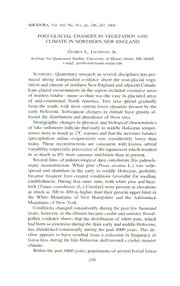
Post-glacial changes in vegetation and climate in northern New England PDF
Preview Post-glacial changes in vegetation and climate in northern New England
RHODORA, No. 246-247, 2000 Vol. 102, 911, pp. CHANGES AND POST-GLACIAL VEGETATION IN NEW CLIMATE NORTHERN ENGLAND IN George Jacobson, L. Jr. ME Institute for Quaternary Studies, University of Maine, Orono, 04469 [email protected] e-mail: Summary. Quaternary research in several disciplines has pro- duced strong independent evidence about the post-glacial vege- New tation and climate of northern England and adjacent Canada. environments Late-glacial in the region included extensive areas — of treeless tundra more so than was the case glaciated areas in of mid-continental North America. Tree taxa spread gradually from the south, with most current forest elements present by the early Holocene. Subsequent changes in climate have greatly af- fected the distribution and abundance of those taxa. Stratigraphic changes physical and in biological characteristics of lake sediments indicate that early to middle Holocene temper- much atures were as as 2''C warmer and that the moisture balance minus was (precipitation evaporation) considerably lower than These known today. reconstructions are consistent with orbital variability (especially precession of the equinoxes) which resulted 8% much more summer in as as insolation than present. at Several lines of paleoecological data corroborate this paleocli- matic reconstruction. White pine {Piuus strobus was wide- L.) spread and abundant in the early to middle Holocene, probably because frequent fires created conditions favorable for seedling During same establishment. that time, both white pine and hem- lock [Tsuga canadensis were (L.) Carriere] present elevations at m much 300 400 as as to higher than present upper their limit in New White Mountains Hampshire the of and Adirondack the New Mountains of York. Conditions changed considerably during few thousand the past however, became years, as the climate cooler and moister. Fossil- pollen evidence shows that the distribution of white pine, which had been so extensive during the drier early and middle Holocene, has diminished consistently during the past 4000 years. This de- appears have from cline to resulted a reduction frequency of in forest fires during the late-Holocene shift toward a cooler, moister cHmate. Within 1000 the past populations of years, several boreal forest 246 — — Jacobson Changes Vegetation and Climate 247 2000] in and balsam taxa, including spruces {Picea spp.) [Abies bal- fir samea (L.) Miller] expanded along the southern margins of their Canada distribution in and the northern tier of the United States^ from Minnesota to Maine. The strong expansion of spruce in the Great Lakes-New England 500 region, especially the past years, summer appears have been associated with cooling of about to 1°C during the Ice Age. Little What Model can be said about the future? General Circulation NCAR CCM3) projections for a future with twice the pre- (e.g., CO^ summer atmospheric concentration of suggest both sent that New may much and winter conditions northern England be in as may warmer as 3°C than at present and that precipitation also be summer may greater. If the models are correct, the conditions be warm warmer 6000 8000 as as or than those to years ago, but possibly also wetter.
